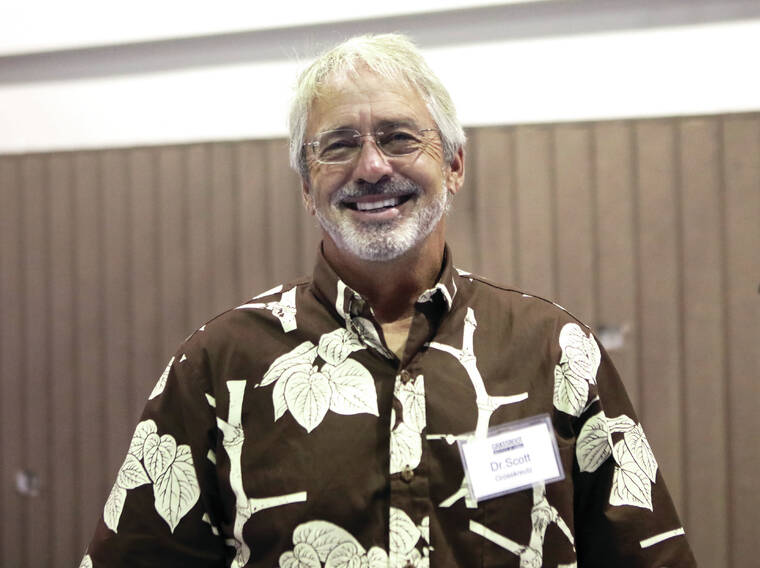Hawaii Island is short roughly 300 physicians, and statewide, that number is estimated to be well over 1,000.
Many physicians on the Big Island also are nearing retirement, with over one-third above the age of 60.
To discuss solutions, the Grassroot Institute of Hawaii, a nonprofit policy research organization, hosted its first Hilo-based presentation on Thursday about how to attract younger health care providers, sustain current staff, and create financial incentives to keep medical professionals in Hawaii.
“We’ve had a shortage of health care providers for as long as I can remember,” said Dr. Scott Grosskreutz, radiologist and head of the Hawaii Physician Shortage Crisis Task Force. “On the Big Island, we had a 53% shortage of doctors, meaning we had less than half of what we were projected to need.”
In addition to the high cost of living, housing prices, a nationwide shortage of health care professionals and burnout from COVID-19, a key concern among the group is the fees and reimbursement rates associated with Medicare, Medicaid and TRICARE patients, which together account for over 50% of patients in Hawaii.
“One of the problems that we have is this very, very low rate of medicare reimbursement in the state of Hawaii,” said Grosskreutz, who noted Medicare and Medicaid are about to cut reimbursements by 8.5% by 2023.
The reimbursements offer funds to doctors and health facilities for providing medical services to Medicare, Medicaid and TRICARE patients, and when those reimbursements are cut, physicians often opt to limit the number of federally covered patients they treat in order to meet their financial bottom lines and keep their practices afloat.
A 2020 survey from the Medical Group Management Association found 92% of practices nationwide reported Medicare reimbursements did not cover the cost of caring for patients, a significant challenge for Hawaii, which has one of the lowest Medicare reimbursements in the nation.
One proposed financial solution from Grassroot Institute is to eliminate the General Excise Tax, or GET, on medical services for group and private practice physicians, with Hawaii being the only state that taxes medical services in this way.
“One of the things we can do here to really help is pass GET reform,” said Grosskreutz, who noted the county rate is 4.7%. “We’ve had a number of candidates from both parties that are supportive of the idea.”
In 2020, Senate Bill 2542 proposed exempting medical services by primary care providers from the GET, which would have placed private providers on an equal playing field as hospitals and other nonprofits in Hawaii that are currently exempt from paying the GET.
The bill noted these forms of taxation already “disproportionately and adversely affect low-income and middle class families struggling to cope with the state’s high cost of living.”
While the bill made its way through the Senate, passing 25-0, it failed to get through the House, with Grosskreutz citing the chaos of the pandemic as a main cause for its failure.
While efforts to reintroduce the bill in 2021 took place, Grosskreutz said he had heard concerns from lawmakers regarding “budget deficiency” as a reason for it failing to gain traction. The GET remains one of the most significant revenue sources for the state, yet despite concerns, Grassroot Institute estimates the 2023 fiscal year budget had a surplus of $4 billion.
A study conducted by the Grassroot Institute estimated that savings for doctors resulting from GET reform could be as high as $222 million a year.
“But of course lawmakers see that as a loss to them because that’s from their budget,” said Joe Kent, executive vice president for the Grassroot Institute.
But one report from the American Medical Association found that physicians on average generate roughly $3 million in economic activity through renting space, hiring local staff, acquiring accountants and using other community resources. With a shortage of roughly 1,000 physicians statewide Grassroot Institute estimates increasing the workforce at that scale could bring an additional $3 billion into the state’s economy.
Both Democratic gubernatorial candidate Josh Green and Republican candidate Duke Aiona have spoken out publicly in favor of addressing GET reform for medicine. Green’s campaign website offers a commitment to address the overall cost of living by “eliminating taxes on food, medicine and other essentials to make Hawaii more affordable,” while Aiona told Hawaii News Now in September that he supported GET reform as it remains “a huge factor for a lot of the doctors who are leaving.”
“Only Hawaii and New Mexico will charge a patient a tax if you get sick or injured,” said Grosskreutz. “It’s hard to describe that as anything other than, in my opinion, unethical.”
A lack of providers can also lead to medical complications for patients, especially when it comes to longer wait times for cancer screenings and other circumstances that require immediate attention.
A recent Access to Care survey published by Community First Hawaii reported roughly 36% of respondents cut back on health care during the pandemic, and 82% of residents on Hawaii Island said they felt there were just not enough providers in general.
The same survey found 49% of health care providers considered moving to the mainland, 53% considered retiring or leaving medicine, and 52% considered reducing their hours.
“Our health care workers in general are understaffed, they’re overworked, and they’re aging out,” said Grosskreutz. “It’s going to really take the general public and the community to lobby for these things to get them passed this session.”
Email Grant Phillips at gphillips@hawaiitribune-herald.com.






